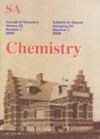Comparative effects of silver nanoparticles, sucrose and sodium chloride as osmotic solutions for tomato slices: antioxidant activity, microbial quality and modelling with polynomial regression model
IF 1
4区 化学
Q4 CHEMISTRY, MULTIDISCIPLINARY
South African Journal of Chemistry-Suid-Afrikaanse Tydskrif Vir Chemie
Pub Date : 2019-02-26
DOI:10.17159/0379-4350/2019/V72A4
引用次数: 11
Abstract
This study has reported comparative effects of silver nanoparticles (AgNPs), sucrose and sodium chloride as osmotic solutions on antioxidant activity and microbial quality of 10 mm tomato slices. 40 g of tomato slices were dehydrated osmotically (OD) at different temperatures (60, 70 and 80 °C) and time (30, 60, 90, 120 150 and 180 min).Water loss, solid impregnation, water and solid diffusivities of tomato slices were found to increase with increase in solution temperatures and concentrations with AgNPs having the greatest influence. Antioxidant activities using 2,2-diphenyl-1-picrylhydrazyl increased with increase in solution concentrations but decreased with increase in temperature. Three-wayANOVA(R2=0.998) revealed additive statistically significant effects of osmotic agents, concentrations and temperatures on antioxidant activity; F(8,54)=67.854,P=0.00. Polynomial regression analysis with response surface methodology validated experiments such that for each unit increase in concentration and temperature, antioxidant activity increased with good coefficients of determination; sucrose (R2 = 0.87), NaCl, (R2 = 0.89) and AgNPs (R2 = 0.91). Potato dextrose and nutrient agars were used for isolating and identifying microorganisms in OD tomato slices. Tomato slices dehydrated with AgNPs had the highest microbial inhibition of fungi with growth occurring after 7 days, unlike in treatments with sucrose and NaCl where fungal growth appeared after 2 and 5 days, respectively. Aspergillus niger was the most prevalent fungus. It can be concluded that AgNPs may serve as a viable means to dehydrate and preserve tomatoes without loss of antioxidant activity. Keywords : Osmotic dehydration, polynomial regression, response surface, antioxidant activity, three-way ANOVA, silver nanoparticles.纳米银、蔗糖和氯化钠作为渗透溶液对番茄片的比较效果:抗氧化活性、微生物质量和多项式回归模型建模
本研究报道了银纳米粒子(AgNPs)、蔗糖和氯化钠作为渗透溶液对10mm番茄片的抗氧化活性和微生物品质的比较影响。40 g番茄片在不同温度(60、70、80℃)和时间(30、60、90、120、150、180 min)下进行渗透脱水(OD)。番茄片的失水率、固体浸渍率、水扩散率和固体扩散率随溶液温度和浓度的增加而增加,其中AgNPs的影响最大。2,2-二苯基-1-苦味酰肼的抗氧化活性随溶液浓度的增加而增加,但随温度的升高而降低。三维方差分析(R2=0.998)表明,渗透剂、浓度和温度对抗氧化活性的影响具有统计学意义;F (54) = 67.854, P = 0.00。响应面法的多项式回归分析验证了实验结果:浓度和温度每增加一个单位,抗氧化活性就会增加,且确定系数较好;蔗糖(R2 = 0.87)、NaCl (R2 = 0.89)和AgNPs (R2 = 0.91)。用马铃薯葡萄糖和营养琼脂分离鉴定了OD番茄切片中的微生物。用AgNPs脱水的番茄片对真菌的抑菌效果最好,7天后才开始生长,而蔗糖和NaCl处理的真菌分别在2天和5天后才开始生长。黑曲霉是最常见的真菌。综上所述,AgNPs可能是一种可行的方法,可以在不丧失抗氧化活性的情况下脱水和保存西红柿。关键词:渗透脱水,多项式回归,响应面,抗氧化活性,三向方差分析,纳米银
本文章由计算机程序翻译,如有差异,请以英文原文为准。
求助全文
约1分钟内获得全文
求助全文
来源期刊
CiteScore
3.10
自引率
0.00%
发文量
6
审稿时长
>12 weeks
期刊介绍:
Original work in all branches of chemistry is published in the South African Journal of Chemistry. Contributions in English may take the form of papers, short communications, or critical reviews.

 求助内容:
求助内容: 应助结果提醒方式:
应助结果提醒方式:


